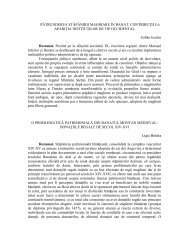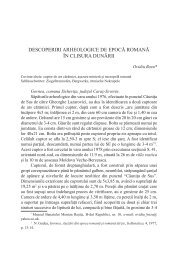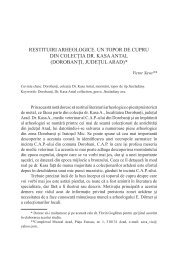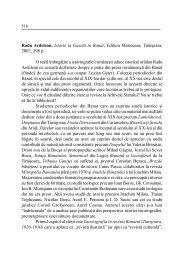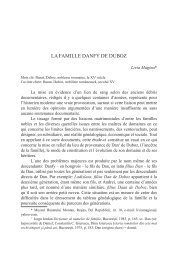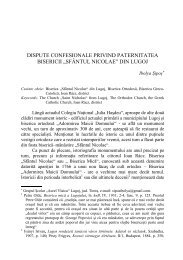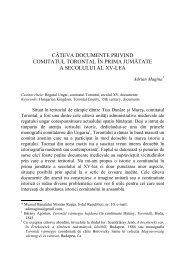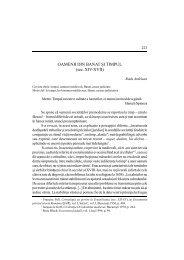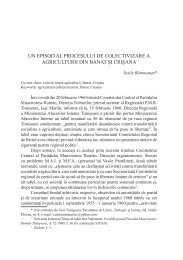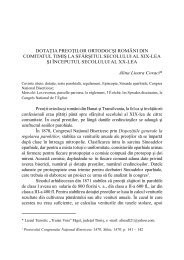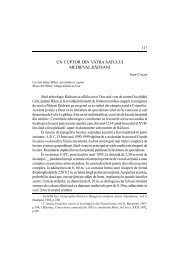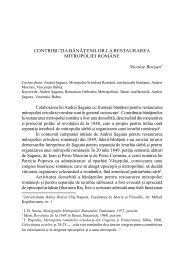Alexandru Simon - Banatica
Alexandru Simon - Banatica
Alexandru Simon - Banatica
You also want an ePaper? Increase the reach of your titles
YUMPU automatically turns print PDFs into web optimized ePapers that Google loves.
‘League of Cambrai’ seemed to work at first. Venice found support against<br />
Vienna neither in Central Europe, nor in Istanbul. Yet, like Central Europe,<br />
Istanbul too was on unstable ground and major changes were in view. In July<br />
1509, Moldavians and Ottomans defeated the Poles. Most likely, the Ottomans<br />
had attacked without Bayezid II’s consent. The sultan did not want to break<br />
the Polish-Ottoman treaty, but since 1508 his control over the empire was rapidly<br />
declining. A new Ottoman civil had become unavoidable by the beginning of<br />
1510 2 .<br />
1. The Walachian and Polish Conflicts of Bogdan III of Moldavia<br />
In spite of the favorable Ottoman circumstances as well of the general<br />
tension within the Muslim world, the Christian neighbors of the empire failed<br />
to achieve any military profits and seemed content with short-term political<br />
gains that allowed them to continue their already traditional local quarrels.<br />
Already in conflict with Radu IV of Walachia and without having a solution to<br />
his Polish problems, Bogdan III wrote to Wladislaw II that Bayezid II was<br />
ready to attack him and that Radu IV had left for Istanbul to receive his orders.<br />
Bogdan urged king Wladislaw to prepare troops in Transylvania for battle. The<br />
king of Hungary did not believe him. He thought that it was a scheme meant to<br />
relieve Polish pressure from Moscow, Suceava’s ally and Krakow’s main enemy<br />
at that moment. Nonetheless, at the same time (summer of 1507), Buda and<br />
2 For Venice and Hungary: V. Fraknói, Lónyay Albert zengi kapitány velenczei követségei 1501-<br />
1515. Közlemények a velenczei állami levéltárból, in MTT, XXII, 1877, nos. 2-5, p. 11-16; no.<br />
16, p. 24 (a key figure in these relations was, after Bakócz, the agile diplomat Philippe (Filip/<br />
Fülöp) More; Tamás Fedeles, Egy Jagelló-kori humanista pályaképe. Csulai Móré Fülöp (1476/<br />
1477-1526), in Levéltári Közlemények, LXXVIII, 2007, 2, p. 35-84. Hungary’s rival factions<br />
and the Ottoman Empire: [George of Sirmium] Szerémi György, Magyorország Romlásáról<br />
1484-1543 (=Monumenta Hungariae Historica, II, 1), edited by Gusztáv Wenzel, Pest, 1857, p.<br />
19-24, 32-39; [John Mihály Brutus] János Mihály Brutus, Magyar históriája 1490-1552 [Ioannnis<br />
Michaelis Bruti Ungricarum Rerum libri qui exstant], I, II. Ulászló király országlata [The Fate<br />
of Country under King Wladislaw II] (= Monumenta Hungariae Historica, II, 12), edited by<br />
Ferenc Toldy, Pest, 1863, p. 14-17; Pál Fodor, The Simurg and the Dragon. The Ottoman Empire<br />
and Hungary (1390-1533), in Fight against the Turk in Central-Europe in the First Half of the<br />
16 th Century, edited by István Zombori, Budapest, 2004, p. 9-35 (p. 21-29). Maximilian after<br />
1505: Hermann Wiesflecker: Maximilian I. Die Fundamente des habsburgischen Weltreiches,<br />
München, 1991, p. 173-181; Manfred Hollegger: Maximilian I.. 1459–1519, Herrscher und<br />
Mensch einer Zeitenwende, Stuttgart, 2005, p. 319-325.<br />
57



